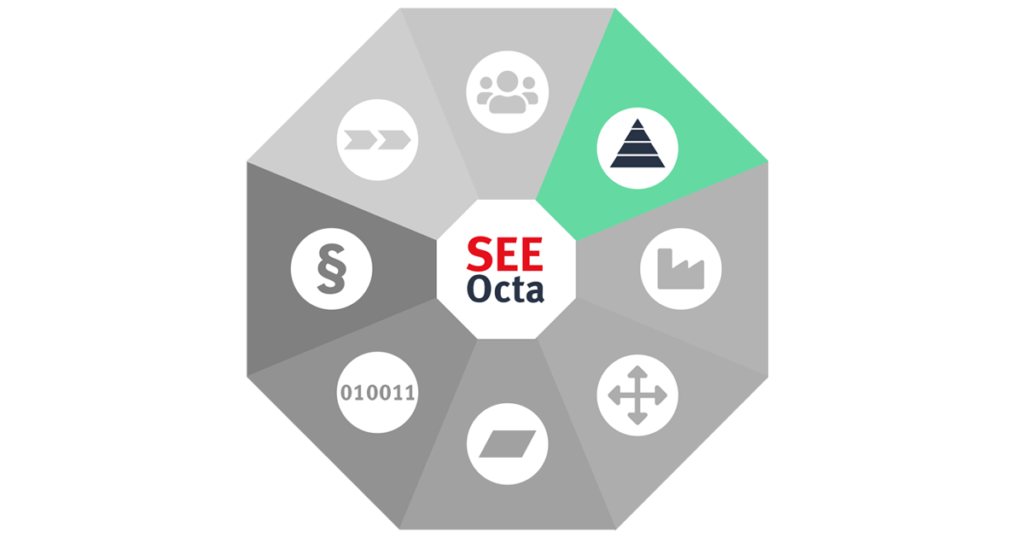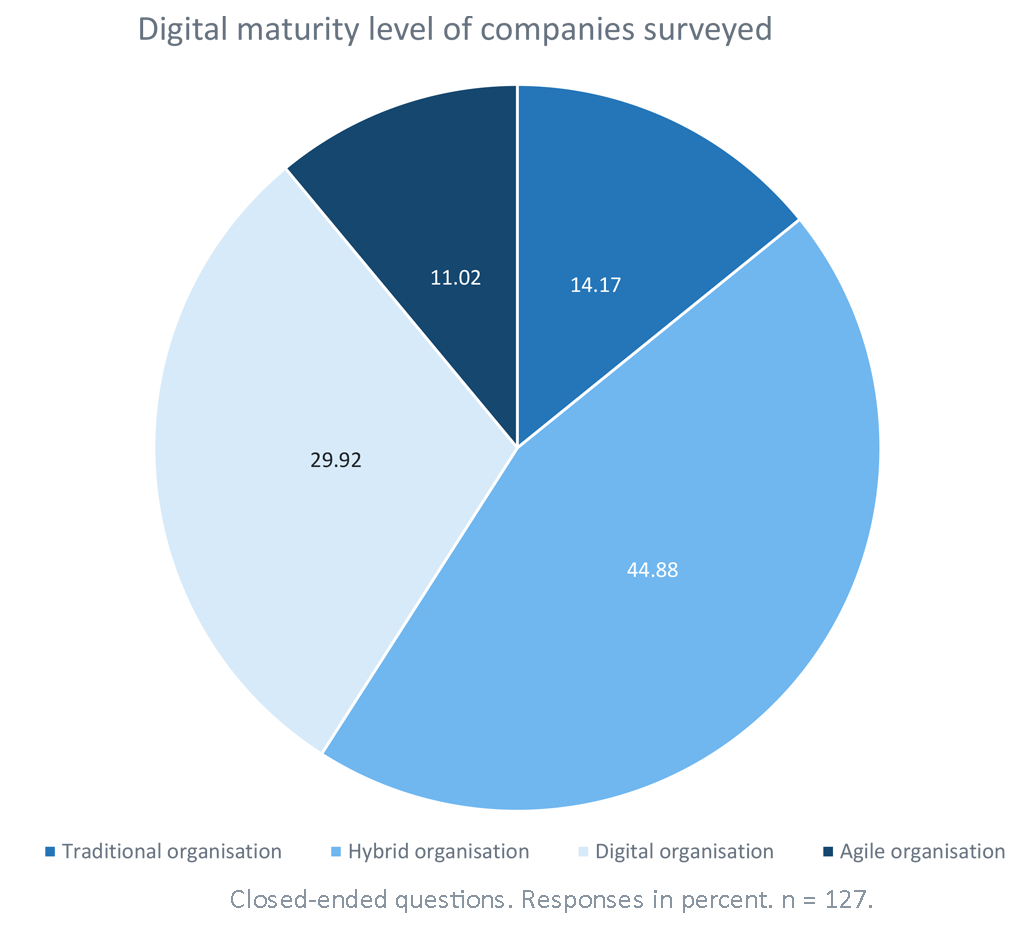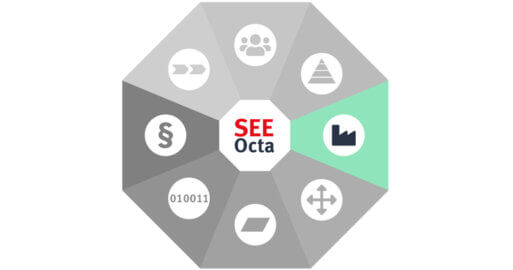SEEOcta: The Agile Organisation

What makes organisations successful and competitive in the long term? They’re not just ahead of the game in speed, flexibility and innovation. They have also managed to keep pace with digital transformation, or even to shape it. They belong to the digital pioneers. This doesn’t just mean that they consider it important to utilise new technologies, but that they have prepared their organisation to be ready for new digital possibilities. The agile organisation contains key elements for companies in the age of digital transformation.
Agile organisations and the digital maturity model
Adopting an agile organisational structure increases the ability of a company to not only adapt quicker and more flexibly to changing demands, but to even (pro)actively shape these themselves. What effects does digitalisation have on organisational structure? In a study from May 2017 entitled the right organisational structure for digital transformation, conducted by Kienbaum on behalf of the Bavarian metal and electronics union bayme vbm[1], a distinction was made between the digital maturity of an organisation and its organisational structure. Companies were split ino the categories of one-dimensional traditional, two-dimensional hybrid digital, and agile.
| Maturity level | Term | Explanation |
| 1 | Traditional Organisation | The organisation has a predominantly traditional structure. No digital initiatives have been started and digital technologies have not influenced either the product/service portfolio, nor the production/performance processes. Digital solutions have also not been extended to customer relationship management. |
| 2 | Hybrid Organisation | Organisational structures are still traditional in nature. There has however been some initial experience and projects with digital offerings. These are confined to certain business areas (i.e. IT, R&D). There is not yet any overarching digital strategy, at least not beyond individual sectors. There is no one with specific responsibility for digital matters |
| 3 | Digital Organisation | There is a digital strategy as well as people entrusted with overseeing digital matters (e.g. CDO or digital manager). Digital business models have been developed with the help of agile development methods. CRM and business processes in particular have been digitalised. The company is actively persuing digital transformation. |
| 4 | Agile Organisation | The organisation acts flexibly, proactively and intuitively, anticipating the changes in the market. The company’s own proceses are digitalised as the situation requires and adapted to the new circumstances. Digital business models are implemented.There is also a broad network or cooperation partners generating digital value (ecosystem). Company culture is innovative and agile. |
Source: Kienbaum
Unsuprisingly, the study came to the conclusion that digitalisation progresses best in companies which have an organisational structure to supports it. Agile companies with high digital maturity are best placed to react quickly to fluctuating demand or changing customer requirements. However, agility and digital maturity are mutually dependent upon each other. Once the right organisational structures have been created, digitalisation opens doors. In this context, Yvonne Balzer, Head of Digital Division at Kienbaum and a member of the senior management team says: „Digitalisation is accompanied by a change from functional organisational structures to agile network organisations. It’s a process of evolution, not revolution.“[2] It is therefore quite sobering to see that around two thirds of the companies in the study are still on the lowest two rungs of the digital maturity scale, just at the start of their digital transformation. Incidentally, there was no connection found between company size and digital maturity. However, industries characterised by short production cycles tended to be more digitally mature.
Would you like to know more about the digital economy and the maturity of digitalization?

Who is responsible for developing an agile organisation?
Who in the company is responsible for transforming a traditional organisation into an agile organisation? According to the above study, a digital transformation can only be successful if driven from within. It’s the companies which declare digitalisation a management issue which are successful. As strategists and deciders, senior management or CEOs are the ideal people to establish and drive forward a holistic digital transformation. Companies which also have their own ditigal unit who is responsible for overseeing a whole-company digital transformation have a particularly high level of digital maturity.

Why we need agile organisational structures
Back in Henry Ford’s day, companies became successful by introducing rigid hierarchical structures. The economical world was simpler, more predictable and therefor easier to control. These days, in our complex, rapidly changing world, this type of organisational structure isn’t effective any more, as the former Nokia CEO discovered to his cost. Shortly before Nokia was taken over by Microsoft, he was forced to admit: “…we didn’t do anything wrong, but somehow, we lost”[3]. Agility is no longer simply an option in our fast-moving times. It determines who succeeds in the market.
Agility is not the same as flexibility
Often, agility is confused with flexibility.An agile organisational structure is indeed flexible, however, a flexible organisational structure is not necessarily agile. Agile is related to active, lively, quick. Flexible, however, means adaptable, pliable. And that’s often the opposite of what puts a company in the lead. Agile organisations are able to shape an environment, creating the conditions themselves. Flexible organisations are only able to adapt to the circumstances others have created. They will survive, but not thrive.
The advantages of an agile organisation
And why is it not enough to simply adapt? Because then you will be overtaken by the competition. The market leaders are those who are able to anticipate and shape customer demand, rather than just following it. Often, customers don’t realise that they want or need something until a resourceful company has shown them what they’re missing. The McKinsey & Company publication ‟The five trademarks of agile organisations‟[4], describes how the following positive effects can follow the transformation into an agile organisation:
- higher customer orientation
- higher customer satisfaction
- shorter time to market
- higher revenues
- higher efficiency
- lower costs
- higher staff motivation
Essentially, greater agility in an organisation enables you above all to react quickly and effectively to new market requirements and conditions.
How to implement an agile organisational structure
How can a company establish an agile organisational structure? There are some measures which can get you started:
- Anchor shared agile values such as courage and openness, focus and commitment into your company’s image, both in your employee’s eyes and in your corporate identity.
- Reduce distance between management and staff and make open, intensive communication the foundation of an agile company culture.
- Encourage staff to organise their workloads themselves, giving them the space and freedom to do their jobs.
- Make incorporating the desires, needs and requirements of your customers into your own considerations and activities a top priority.
- Establish a culture of openness and trust, instead of the checks and decrees often found in a hierarchical, Taylorist organisational structure.
- Adopt agile work processes and methods so that you can adapt quicker to changes. An example is a daily stand-up meeting of 15 minutes or less.
Agile organisations need agile employees
Agile organisations need to be lived. Idealy, they consist of employees who not only have excellent professional skills, but who are also interested in a number of areas and are keen to keep learning. They have high moral values which fit well to the agile company values described above. As they learn, employees motivate themselves to perform well in their areas of expertise, which in turn spurs them on to continue performing. In return, they expect a high level of tangible appreciation from others. It is important to them to be part of a community of values.
Organisational areas perfect for agile teams
The organisational areas of a company in which “intellectual value creation” takes place are designed in a particularly agile way. They fully implement agile principles and are organised in the form of agile teams. First and foremost, these are the research and development areas. Prototyping, marketing, sales, toolmaking and many service areas can also have good examples of agile structures, although this can depend to a certain extent on the industry. In classic manufacturing industries, where goods are mass produced, we find forms of lean organisation, which is also counted as an agile organisational structure.
In conclusion
If introducing new IT systems is to successfully lead to a proper digital transformation, it is necessary for the company to evolve from traditional to agile organisational structures. This in turn needs the right leadership approach, well thought-out operational concepts, support systems as well as the right staff with a synergetic mix of characteristics. Agil structures are then further supported by a culture of trust, openness and collaboration.
Compared to traditional ‘silo’ organisations, agile organisations remain robust and effective regardless of the tasks, situations or conditions with which they are confronted. They react proactively and quickly to destabilising disruptions in the business or market environments. Agile organisations are able to innovatively deploy multiple types of solutions and seamlessly transition from one to another. This allows them to efficiently adapt by agily changing work processes and organisational structures depending on the situation they are in, or wish to shape.
[1] https://www.baymevbm.de/Redaktion/Frei-zugaengliche-Medien/Abteilungen-GS/Regionen-und-Marketing/2017/Downloads/17-05-10-Studie-Organisationsformen-final-%C3%B6ffentlich.pdf
[2] https://www.fortis-it.de/2017/09/19/agile-organisation-befoerdert-den-digitalen-wandel/
[3] https://www.leadership-choices.com/de/
[4] https://www.mckinsey.com/business-functions/organization/our-insights/the-five-trademarks-of-agile-organizations
Thank you for your message
We appreciate your interest in SEEBURGER
Get in contact with us:
Please enter details about your project in the message section so we can direct your inquiry to the right consultant.
Written by: Rolf Holicki
Rolf Holicki, Director BU E-Invoicing, SAP&Web Process, is responsible for the SAP/WEB applications and digitization expert. He has more than 25 years of experience in e-invoicing, SAP, Workflow and business process automation. Rolf Holicki has been with SEEBURGER since 2005.



